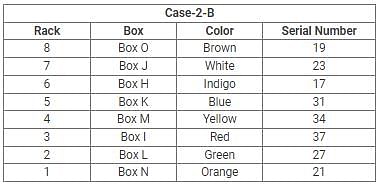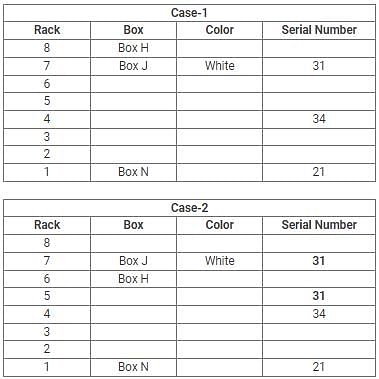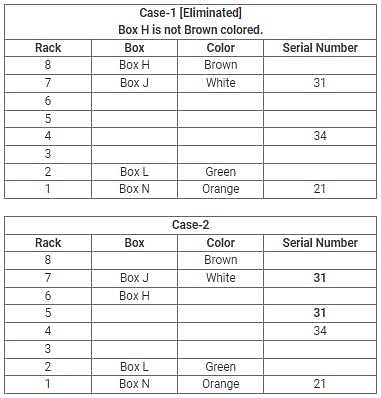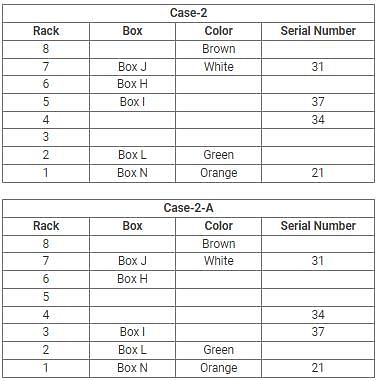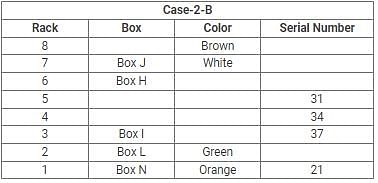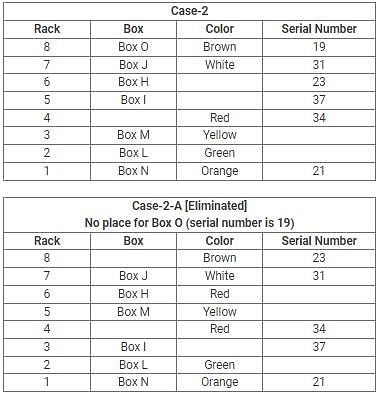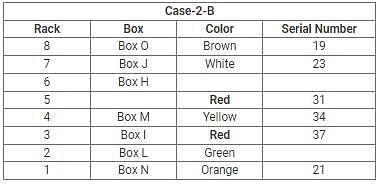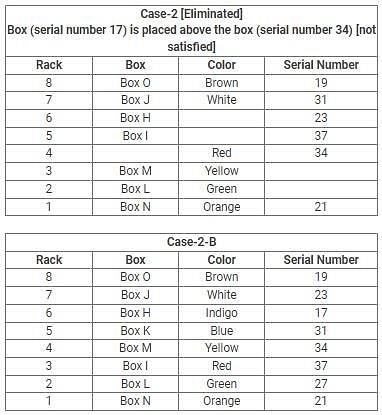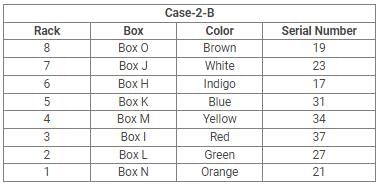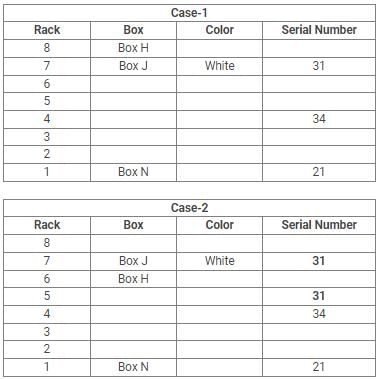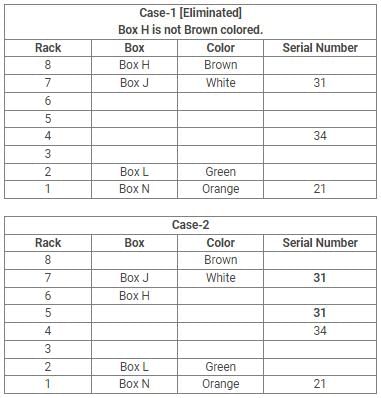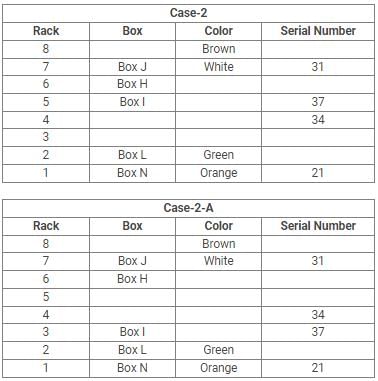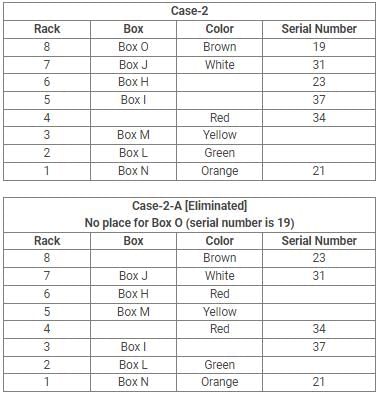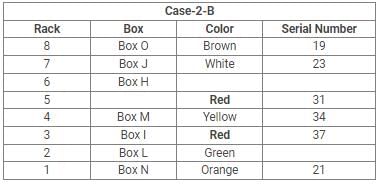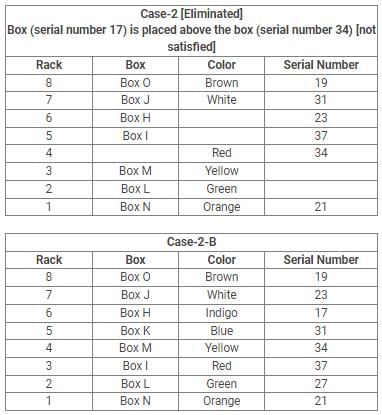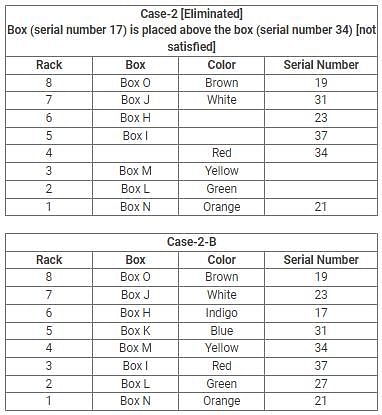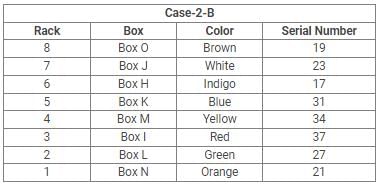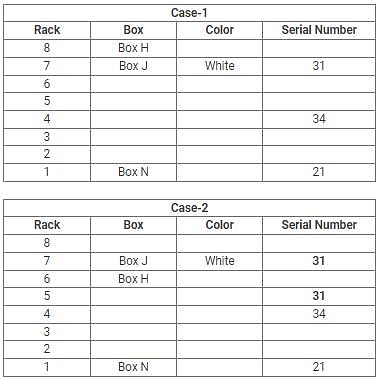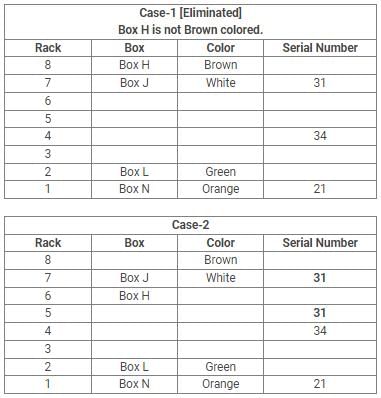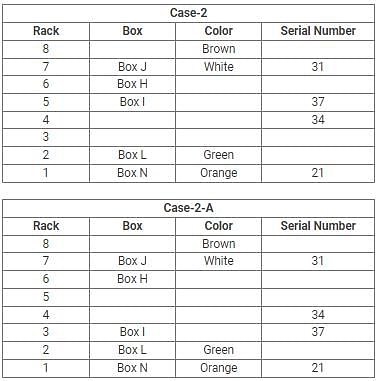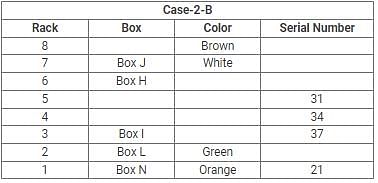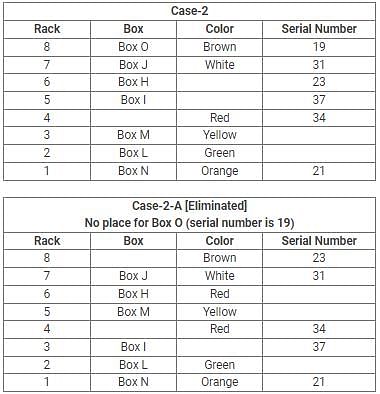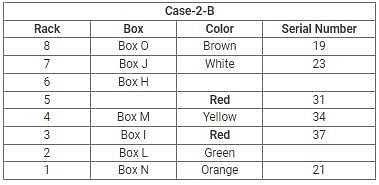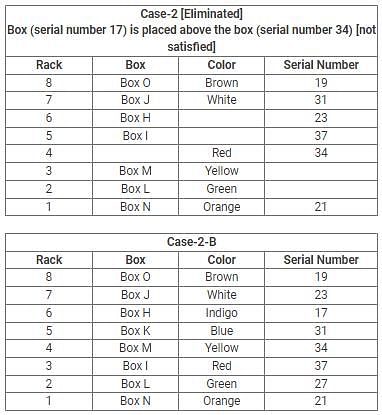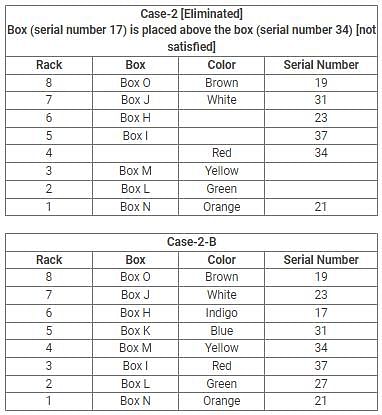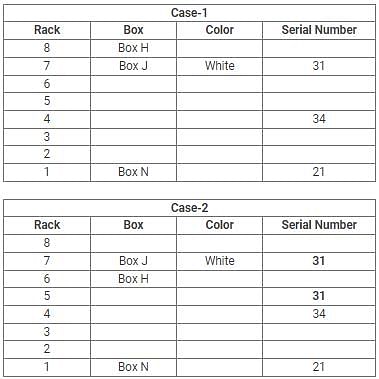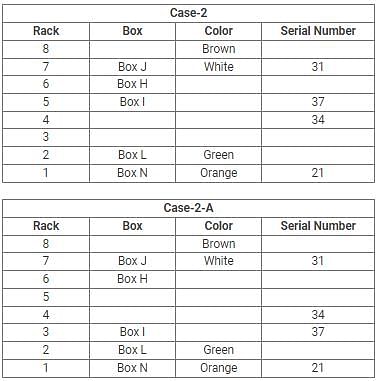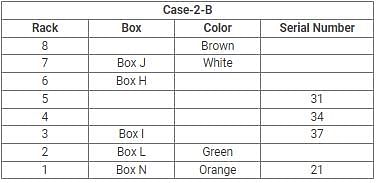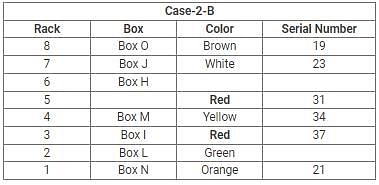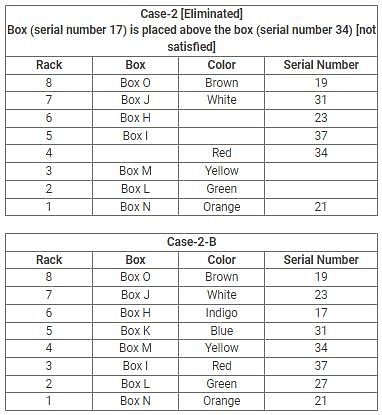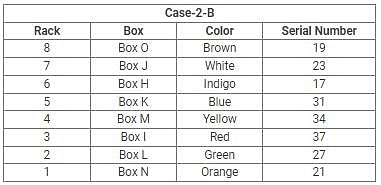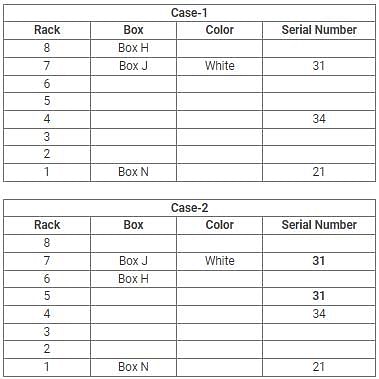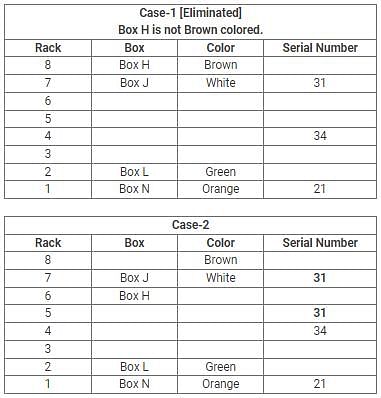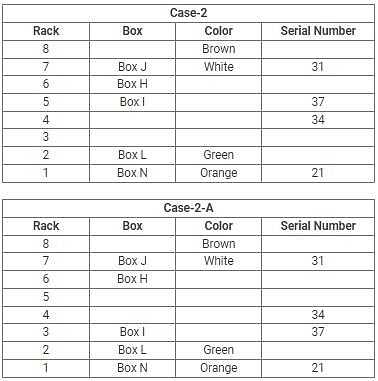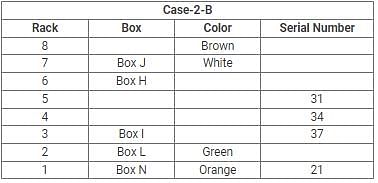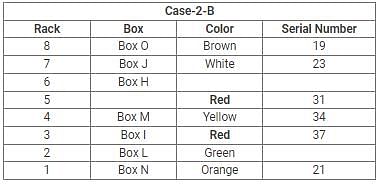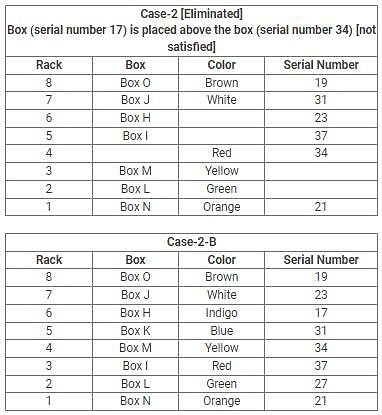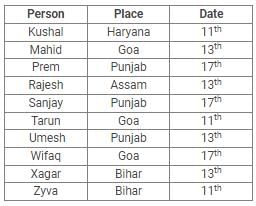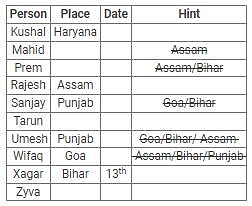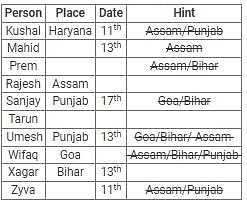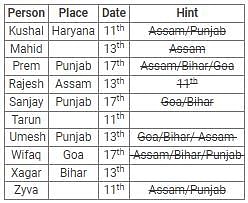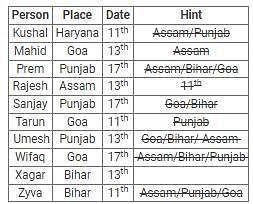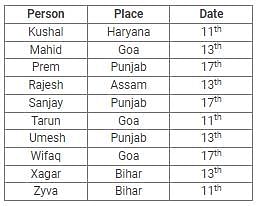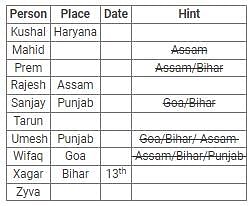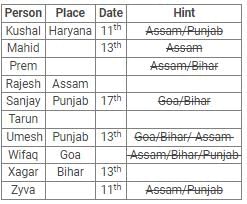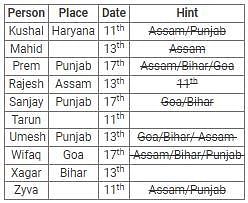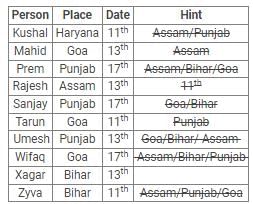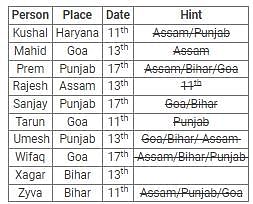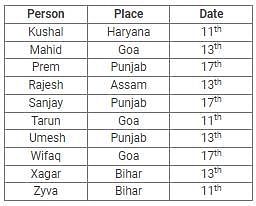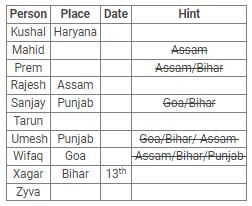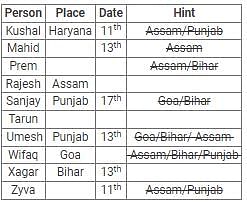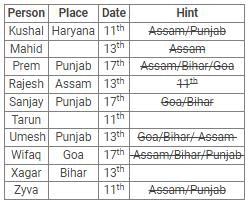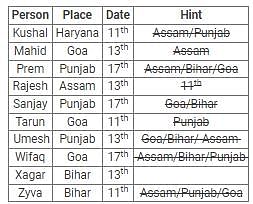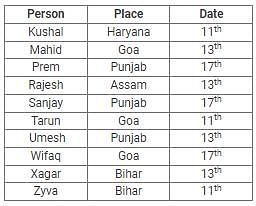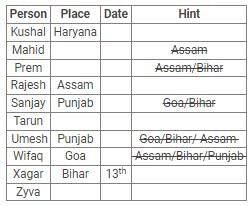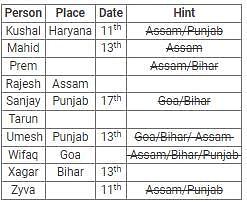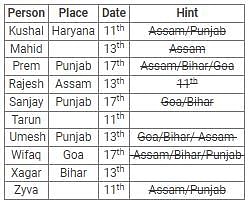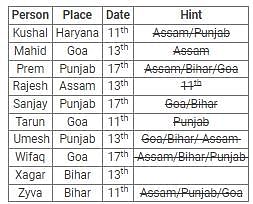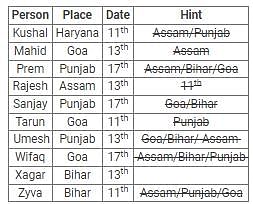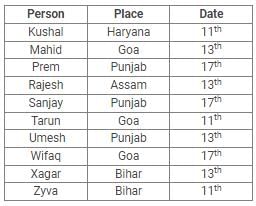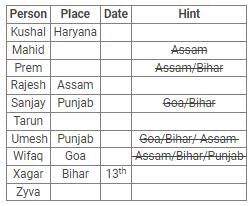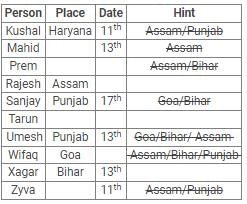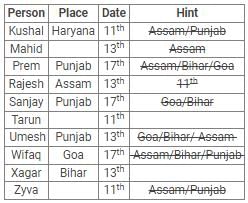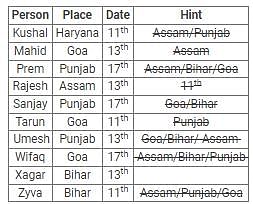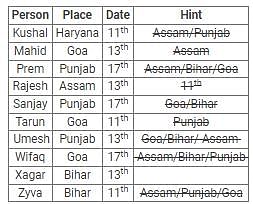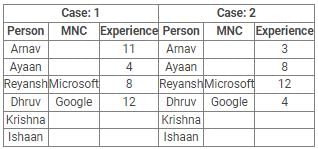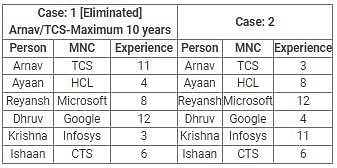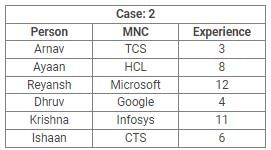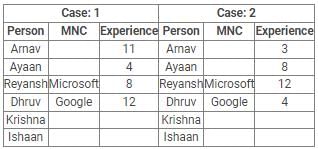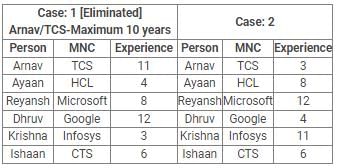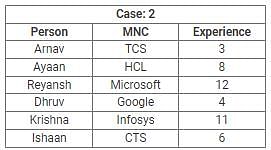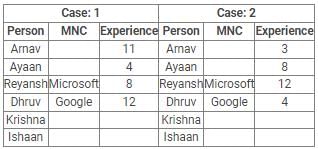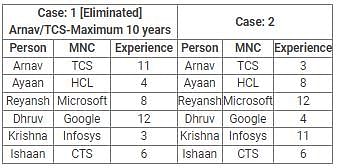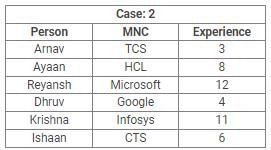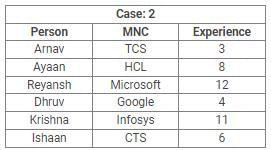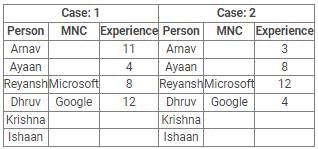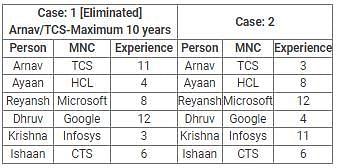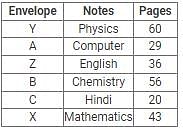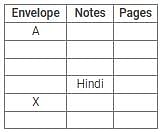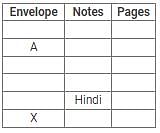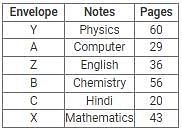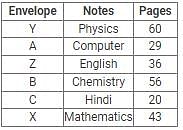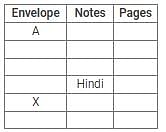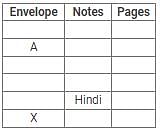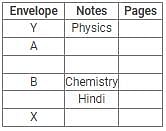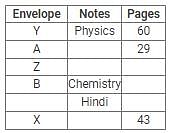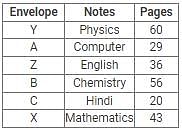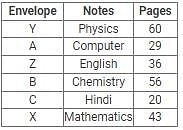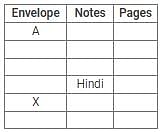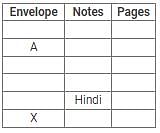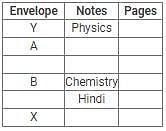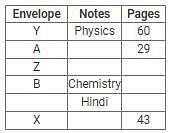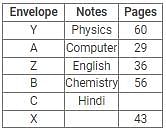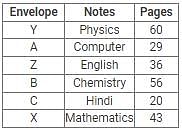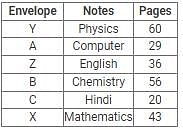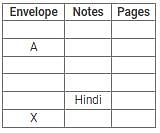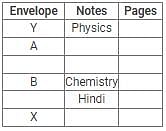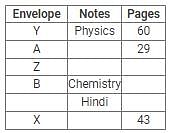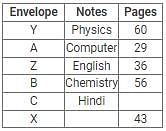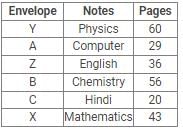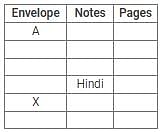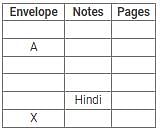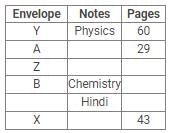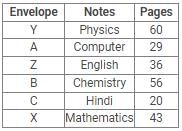MCQ Test: Box Based Puzzle - 1 - Bank Exams MCQ
20 Questions MCQ Test Reasoning Aptitude for Competitive Examinations - MCQ Test: Box Based Puzzle - 1
Directions: Read the given information carefully and answer the questions given beside:
Eight boxes namely H to O are placed in a rack one above the other. The lowermost rack is numbered as 1 and above is 2 and so on. Each of the boxes is having different colors among Blue, Green, Yellow, Red, White, Orange, Indigo and Brown. Each of the boxes is having different serial numbers among 19, 23, 17, 31, 34, 37, 27 and 21. All the above information is not necessarily in the same order.
There are three boxes are placed between the box which having serial number as 27 and the Indigo colored box. Box J’s serial number is not 27. The Indigo colored box is placed adjacent to blue colored box. Box I’s serial number is 37 and doesn’t placed at the topmost rack. Box M is Yellow colored and placed adjacent to the Red colored box. Box H is placed in the even numbered rack above fourth and it is placed adjacent to box which has serial number as 31. Not more than five boxes are placed above the Red colored box. Box J is placed in the seventh rack and Box H is placed adjacent to Box J. Two boxes are placed between the boxes having the serial number 21 and 34. Box J is White colored. Maximum numbers of boxes are placed between the Brown colored box and Orange colored box. Box H is not Brown colored. Box L is Green colored and it is placed adjacent to the Orange colored box. Box N’s serial number is 21 and placed in the lowermost rack. The box which has serial number as 23 is placed three boxes above the Yellow colored box. Box O’s serial number is 19. The box which has serial number as 17 is placed above the box which has serial number as 34.
Q. What is the serial number of Box H?
Eight boxes namely H to O are placed in a rack one above the other. The lowermost rack is numbered as 1 and above is 2 and so on. Each of the boxes is having different colors among Blue, Green, Yellow, Red, White, Orange, Indigo and Brown. Each of the boxes is having different serial numbers among 19, 23, 17, 31, 34, 37, 27 and 21. All the above information is not necessarily in the same order.
There are three boxes are placed between the box which having serial number as 27 and the Indigo colored box. Box J’s serial number is not 27. The Indigo colored box is placed adjacent to blue colored box. Box I’s serial number is 37 and doesn’t placed at the topmost rack. Box M is Yellow colored and placed adjacent to the Red colored box. Box H is placed in the even numbered rack above fourth and it is placed adjacent to box which has serial number as 31. Not more than five boxes are placed above the Red colored box. Box J is placed in the seventh rack and Box H is placed adjacent to Box J. Two boxes are placed between the boxes having the serial number 21 and 34. Box J is White colored. Maximum numbers of boxes are placed between the Brown colored box and Orange colored box. Box H is not Brown colored. Box L is Green colored and it is placed adjacent to the Orange colored box. Box N’s serial number is 21 and placed in the lowermost rack. The box which has serial number as 23 is placed three boxes above the Yellow colored box. Box O’s serial number is 19. The box which has serial number as 17 is placed above the box which has serial number as 34.
Directions: Read the given information carefully and answer the questions given beside:
Eight boxes namely H to O are placed in a rack one above the other. The lowermost rack is numbered as 1 and above is 2 and so on. Each of the boxes is having different colors among Blue, Green, Yellow, Red, White, Orange, Indigo and Brown. Each of the boxes is having different serial numbers among 19, 23, 17, 31, 34, 37, 27 and 21. All the above information is not necessarily in the same order.
There are three boxes are placed between the box which having serial number as 27 and the Indigo colored box. Box J’s serial number is not 27. The Indigo colored box is placed adjacent to blue colored box. Box I’s serial number is 37 and doesn’t placed at the topmost rack. Box M is Yellow colored and placed adjacent to the Red colored box. Box H is placed in the even numbered rack above fourth and it is placed adjacent to box which has serial number as 31. Not more than five boxes are placed above the Red colored box. Box J is placed in the seventh rack and Box H is placed adjacent to Box J. Two boxes are placed between the boxes having the serial number 21 and 34. Box J is White colored. Maximum numbers of boxes are placed between the Brown colored box and Orange colored box. Box H is not Brown colored. Box L is Green colored and it is placed adjacent to the Orange colored box. Box N’s serial number is 21 and placed in the lowermost rack. The box which has serial number as 23 is placed three boxes above the Yellow colored box. Box O’s serial number is 19. The box which has serial number as 17 is placed above the box which has serial number as 34.
Q. Which among following combination is true?
Eight boxes namely H to O are placed in a rack one above the other. The lowermost rack is numbered as 1 and above is 2 and so on. Each of the boxes is having different colors among Blue, Green, Yellow, Red, White, Orange, Indigo and Brown. Each of the boxes is having different serial numbers among 19, 23, 17, 31, 34, 37, 27 and 21. All the above information is not necessarily in the same order.
There are three boxes are placed between the box which having serial number as 27 and the Indigo colored box. Box J’s serial number is not 27. The Indigo colored box is placed adjacent to blue colored box. Box I’s serial number is 37 and doesn’t placed at the topmost rack. Box M is Yellow colored and placed adjacent to the Red colored box. Box H is placed in the even numbered rack above fourth and it is placed adjacent to box which has serial number as 31. Not more than five boxes are placed above the Red colored box. Box J is placed in the seventh rack and Box H is placed adjacent to Box J. Two boxes are placed between the boxes having the serial number 21 and 34. Box J is White colored. Maximum numbers of boxes are placed between the Brown colored box and Orange colored box. Box H is not Brown colored. Box L is Green colored and it is placed adjacent to the Orange colored box. Box N’s serial number is 21 and placed in the lowermost rack. The box which has serial number as 23 is placed three boxes above the Yellow colored box. Box O’s serial number is 19. The box which has serial number as 17 is placed above the box which has serial number as 34.
| 1 Crore+ students have signed up on EduRev. Have you? Download the App |
Directions: Read the given information carefully and answer the questions given beside:
Eight boxes namely H to O are placed in a rack one above the other. The lowermost rack is numbered as 1 and above is 2 and so on. Each of the boxes is having different colors among Blue, Green, Yellow, Red, White, Orange, Indigo and Brown. Each of the boxes is having different serial numbers among 19, 23, 17, 31, 34, 37, 27 and 21. All the above information is not necessarily in the same order.
There are three boxes are placed between the box which having serial number as 27 and the Indigo colored box. Box J’s serial number is not 27. The Indigo colored box is placed adjacent to blue colored box. Box I’s serial number is 37 and doesn’t placed at the topmost rack. Box M is Yellow colored and placed adjacent to the Red colored box. Box H is placed in the even numbered rack above fourth and it is placed adjacent to box which has serial number as 31. Not more than five boxes are placed above the Red colored box. Box J is placed in the seventh rack and Box H is placed adjacent to Box J. Two boxes are placed between the boxes having the serial number 21 and 34. Box J is White colored. Maximum numbers of boxes are placed between the Brown colored box and Orange colored box. Box H is not Brown colored. Box L is Green colored and it is placed adjacent to the Orange colored box. Box N’s serial number is 21 and placed in the lowermost rack. The box which has serial number as 23 is placed three boxes above the Yellow colored box. Box O’s serial number is 19. The box which has serial number as 17 is placed above the box which has serial number as 34.
Q. In certain way Box O is related to serial number 17, Box H is related to serial number 34 and in same way Box M is related to which among the following serial number?
Eight boxes namely H to O are placed in a rack one above the other. The lowermost rack is numbered as 1 and above is 2 and so on. Each of the boxes is having different colors among Blue, Green, Yellow, Red, White, Orange, Indigo and Brown. Each of the boxes is having different serial numbers among 19, 23, 17, 31, 34, 37, 27 and 21. All the above information is not necessarily in the same order.
There are three boxes are placed between the box which having serial number as 27 and the Indigo colored box. Box J’s serial number is not 27. The Indigo colored box is placed adjacent to blue colored box. Box I’s serial number is 37 and doesn’t placed at the topmost rack. Box M is Yellow colored and placed adjacent to the Red colored box. Box H is placed in the even numbered rack above fourth and it is placed adjacent to box which has serial number as 31. Not more than five boxes are placed above the Red colored box. Box J is placed in the seventh rack and Box H is placed adjacent to Box J. Two boxes are placed between the boxes having the serial number 21 and 34. Box J is White colored. Maximum numbers of boxes are placed between the Brown colored box and Orange colored box. Box H is not Brown colored. Box L is Green colored and it is placed adjacent to the Orange colored box. Box N’s serial number is 21 and placed in the lowermost rack. The box which has serial number as 23 is placed three boxes above the Yellow colored box. Box O’s serial number is 19. The box which has serial number as 17 is placed above the box which has serial number as 34.
Directions: Read the given information carefully and answer the questions given beside:
Eight boxes namely H to O are placed in a rack one above the other. The lowermost rack is numbered as 1 and above is 2 and so on. Each of the boxes is having different colors among Blue, Green, Yellow, Red, White, Orange, Indigo and Brown. Each of the boxes is having different serial numbers among 19, 23, 17, 31, 34, 37, 27 and 21. All the above information is not necessarily in the same order.
There are three boxes are placed between the box which having serial number as 27 and the Indigo colored box. Box J’s serial number is not 27. The Indigo colored box is placed adjacent to blue colored box. Box I’s serial number is 37 and doesn’t placed at the topmost rack. Box M is Yellow colored and placed adjacent to the Red colored box. Box H is placed in the even numbered rack above fourth and it is placed adjacent to box which has serial number as 31. Not more than five boxes are placed above the Red colored box. Box J is placed in the seventh rack and Box H is placed adjacent to Box J. Two boxes are placed between the boxes having the serial number 21 and 34. Box J is White colored. Maximum numbers of boxes are placed between the Brown colored box and Orange colored box. Box H is not Brown colored. Box L is Green colored and it is placed adjacent to the Orange colored box. Box N’s serial number is 21 and placed in the lowermost rack. The box which has serial number as 23 is placed three boxes above the Yellow colored box. Box O’s serial number is 19. The box which has serial number as 17 is placed above the box which has serial number as 34.
Q. Which of the following statements is true?
Directions: Read the given information carefully and answer the questions given beside:
Eight boxes namely H to O are placed in a rack one above the other. The lowermost rack is numbered as 1 and above is 2 and so on. Each of the boxes is having different colors among Blue, Green, Yellow, Red, White, Orange, Indigo and Brown. Each of the boxes is having different serial numbers among 19, 23, 17, 31, 34, 37, 27 and 21. All the above information is not necessarily in the same order.
There are three boxes are placed between the box which having serial number as 27 and the Indigo colored box. Box J’s serial number is not 27. The Indigo colored box is placed adjacent to blue colored box. Box I’s serial number is 37 and doesn’t placed at the topmost rack. Box M is Yellow colored and placed adjacent to the Red colored box. Box H is placed in the even numbered rack above fourth and it is placed adjacent to box which has serial number as 31. Not more than five boxes are placed above the Red colored box. Box J is placed in the seventh rack and Box H is placed adjacent to Box J. Two boxes are placed between the boxes having the serial number 21 and 34. Box J is White colored. Maximum numbers of boxes are placed between the Brown colored box and Orange colored box. Box H is not Brown colored. Box L is Green colored and it is placed adjacent to the Orange colored box. Box N’s serial number is 21 and placed in the lowermost rack. The box which has serial number as 23 is placed three boxes above the Yellow colored box. Box O’s serial number is 19. The box which has serial number as 17 is placed above the box which has serial number as 34.
Q. Four of the following five are alike in a certain way and hence form a group. Which of the following does not belong to the group?
Directions: Read the given information carefully and answer the questions given beside:
Ten persons namely Kushal, Mahid, Prem, Rajesh, Sanjay, Tarun, Umesh, Wifaq, Xagar and Zyva are travelling to five different states Goa, Punjab, Haryana, Assam and Bihar on either 11th or 13th or 17th of the same month, but not necessarily in the same order.
At least one person is travelling to Goa on each date. Not more than three persons are travelling in the same state. Only Kushal is travelling to Haryana. Rajesh is travelling to Assam. Sanjay and Umesh are travelling in the same state, but not travelling to either Goa or Bihar. Wifaq and Prem are travelling on the same date. Neither Prem nor Wifaq is travelling to Bihar. Prem and Rajesh are travelling on the different date. Neither Prem nor Wifaq is travelling to the same city as Rajesh. Wifaq does not travel to Punjab. Xagar is travelling to Bihar on 13th of the month. Umesh and Xagar are travelling on the same date. Only two persons are travelling to Bihar, but none of them is travelling on 17th of the month. No one is travelling to Assam and Punjab on 11th of the month. Only four persons are travelling on 13th of the month. Only three persons are travelling on 11th of the month. Sanjay is travelling on neither 11th nor 13th of the month. Umesh and Mahid are travelling on the same date, but none of them is travelling to Assam. Kushal and Sanjay does not travel on the same date. Kushal and Zyva are travelling on the same date. Mahid and Zyva do not travel to the same state.
Q. Who among the following persons is/are travelling to Bihar?
Directions: Read the given information carefully and answer the questions given beside:
Ten persons namely Kushal, Mahid, Prem, Rajesh, Sanjay, Tarun, Umesh, Wifaq, Xagar and Zyva are travelling to five different states Goa, Punjab, Haryana, Assam and Bihar on either 11th or 13th or 17th of the same month, but not necessarily in the same order.
At least one person is travelling to Goa on each date. Not more than three persons are travelling in the same state. Only Kushal is travelling to Haryana. Rajesh is travelling to Assam. Sanjay and Umesh are travelling in the same state, but not travelling to either Goa or Bihar. Wifaq and Prem are travelling on the same date. Neither Prem nor Wifaq is travelling to Bihar. Prem and Rajesh are travelling on the different date. Neither Prem nor Wifaq is travelling to the same city as Rajesh. Wifaq does not travel to Punjab. Xagar is travelling to Bihar on 13th of the month. Umesh and Xagar are travelling on the same date. Only two persons are travelling to Bihar, but none of them is travelling on 17th of the month. No one is travelling to Assam and Punjab on 11th of the month. Only four persons are travelling on 13th of the month. Only three persons are travelling on 11th of the month. Sanjay is travelling on neither 11th nor 13th of the month. Umesh and Mahid are travelling on the same date, but none of them is travelling to Assam. Kushal and Sanjay does not travel on the same date. Kushal and Zyva are travelling on the same date. Mahid and Zyva do not travel to the same state.
Q. Four of the following five are alike in a certain way and hence form a group. Which of the following does not belong to the group?
Directions: Read the given information carefully and answer the questions given beside:
Ten persons namely Kushal, Mahid, Prem, Rajesh, Sanjay, Tarun, Umesh, Wifaq, Xagar and Zyva are travelling to five different states Goa, Punjab, Haryana, Assam and Bihar on either 11th or 13th or 17th of the same month, but not necessarily in the same order.
At least one person is travelling to Goa on each date. Not more than three persons are travelling in the same state. Only Kushal is travelling to Haryana. Rajesh is travelling to Assam. Sanjay and Umesh are travelling in the same state, but not travelling to either Goa or Bihar. Wifaq and Prem are travelling on the same date. Neither Prem nor Wifaq is travelling to Bihar. Prem and Rajesh are travelling on the different date. Neither Prem nor Wifaq is travelling to the same city as Rajesh. Wifaq does not travel to Punjab. Xagar is travelling to Bihar on 13th of the month. Umesh and Xagar are travelling on the same date. Only two persons are travelling to Bihar, but none of them is travelling on 17th of the month. No one is travelling to Assam and Punjab on 11th of the month. Only four persons are travelling on 13th of the month. Only three persons are travelling on 11th of the month. Sanjay is travelling on neither 11th nor 13th of the month. Umesh and Mahid are travelling on the same date, but none of them is travelling to Assam. Kushal and Sanjay does not travel on the same date. Kushal and Zyva are travelling on the same date. Mahid and Zyva do not travel to the same state.
Q. Which of the following combinations is true?
Directions: Read the given information carefully and answer the questions given beside:
Ten persons namely Kushal, Mahid, Prem, Rajesh, Sanjay, Tarun, Umesh, Wifaq, Xagar and Zyva are travelling to five different states Goa, Punjab, Haryana, Assam and Bihar on either 11th or 13th or 17th of the same month, but not necessarily in the same order.
At least one person is travelling to Goa on each date. Not more than three persons are travelling in the same state. Only Kushal is travelling to Haryana. Rajesh is travelling to Assam. Sanjay and Umesh are travelling in the same state, but not travelling to either Goa or Bihar. Wifaq and Prem are travelling on the same date. Neither Prem nor Wifaq is travelling to Bihar. Prem and Rajesh are travelling on the different date. Neither Prem nor Wifaq is travelling to the same city as Rajesh. Wifaq does not travel to Punjab. Xagar is travelling to Bihar on 13th of the month. Umesh and Xagar are travelling on the same date. Only two persons are travelling to Bihar, but none of them is travelling on 17th of the month. No one is travelling to Assam and Punjab on 11th of the month. Only four persons are travelling on 13th of the month. Only three persons are travelling on 11th of the month. Sanjay is travelling on neither 11th nor 13th of the month. Umesh and Mahid are travelling on the same date, but none of them is travelling to Assam. Kushal and Sanjay does not travel on the same date. Kushal and Zyva are travelling on the same date. Mahid and Zyva do not travel to the same state.
Q. Who among the following persons is travelling to Goa?
Directions: Read the given information carefully and answer the questions given beside:
Ten persons namely Kushal, Mahid, Prem, Rajesh, Sanjay, Tarun, Umesh, Wifaq, Xagar and Zyva are travelling to five different states Goa, Punjab, Haryana, Assam and Bihar on either 11th or 13th or 17th of the same month, but not necessarily in the same order.
At least one person is travelling to Goa on each date. Not more than three persons are travelling in the same state. Only Kushal is travelling to Haryana. Rajesh is travelling to Assam. Sanjay and Umesh are travelling in the same state, but not travelling to either Goa or Bihar. Wifaq and Prem are travelling on the same date. Neither Prem nor Wifaq is travelling to Bihar. Prem and Rajesh are travelling on the different date. Neither Prem nor Wifaq is travelling to the same city as Rajesh. Wifaq does not travel to Punjab. Xagar is travelling to Bihar on 13th of the month. Umesh and Xagar are travelling on the same date. Only two persons are travelling to Bihar, but none of them is travelling on 17th of the month. No one is travelling to Assam and Punjab on 11th of the month. Only four persons are travelling on 13th of the month. Only three persons are travelling on 11th of the month. Sanjay is travelling on neither 11th nor 13th of the month. Umesh and Mahid are travelling on the same date, but none of them is travelling to Assam. Kushal and Sanjay does not travel on the same date. Kushal and Zyva are travelling on the same date. Mahid and Zyva do not travel to the same state.
Q. Who among the following persons is travelling on 11th of the month?
Directions: Read the given information carefully and answer the questions given beside:
There are six friends namely Arnav, Ayaan, Reyansh, Dhruv, Krishna and Ishaan. Each of them are working in different MNC’s like TCS, Google, Infosys, CTS, HCL and Microsoft but not necessarily in the same order. Each of them is having different years of work experience among 3, 4, 6, 8, 11 and 12 but not necessarily in the same order.
Reyansh, who works in Microsoft, has 4 years experience more than that of Ayaan.
Dhruv, who works in Google, has 1 year experience more than that of Arnav.
The difference between the number of years in experience of the person who works in HCL and Ishaan, who works in CTS, is 2.
Krishna works in Infosys Company.
The person who works in TCS has experience of at most 10 years.
Q. How many years of experience does the one has who works in TCS?
Directions: Read the given information carefully and answer the questions given beside:
There are six friends namely Arnav, Ayaan, Reyansh, Dhruv, Krishna and Ishaan. Each of them are working in different MNC’s like TCS, Google, Infosys, CTS, HCL and Microsoft but not necessarily in the same order. Each of them is having different years of work experience among 3, 4, 6, 8, 11 and 12 but not necessarily in the same order.
Reyansh, who works in Microsoft, has 4 years experience more than that of Ayaan.
Dhruv, who works in Google, has 1 year experience more than that of Arnav.
The difference between the number of years in experience of the person who works in HCL and Ishaan, who works in CTS, is 2.
Krishna works in Infosys Company.
The person who works in TCS has experience of at most 10 years.
Q. Who has the maximum years of experience?
Directions: Read the given information carefully and answer the questions given beside:
There are six friends namely Arnav, Ayaan, Reyansh, Dhruv, Krishna and Ishaan. Each of them are working in different MNC’s like TCS, Google, Infosys, CTS, HCL and Microsoft but not necessarily in the same order. Each of them is having different years of work experience among 3, 4, 6, 8, 11 and 12 but not necessarily in the same order.
Reyansh, who works in Microsoft, has 4 years experience more than that of Ayaan.
Dhruv, who works in Google, has 1 year experience more than that of Arnav.
The difference between the number of years in experience of the person who works in HCL and Ishaan, who works in CTS, is 2.
Krishna works in Infosys Company.
The person who works in TCS has experience of at most 10 years.
Q. What is the sum of the years of experience of both Ayaan and Arnav?
Directions: Read the given information carefully and answer the questions given beside:
There are six friends namely Arnav, Ayaan, Reyansh, Dhruv, Krishna and Ishaan. Each of them are working in different MNC’s like TCS, Google, Infosys, CTS, HCL and Microsoft but not necessarily in the same order. Each of them is having different years of work experience among 3, 4, 6, 8, 11 and 12 but not necessarily in the same order.
Reyansh, who works in Microsoft, has 4 years experience more than that of Ayaan.
Dhruv, who works in Google, has 1 year experience more than that of Arnav.
The difference between the number of years in experience of the person who works in HCL and Ishaan, who works in CTS, is 2.
Krishna works in Infosys Company.
The person who works in TCS has experience of at most 10 years.
Q. Which of the following persons works in HCL?
Directions: Read the given information carefully and answer the questions given beside:
There are six friends namely Arnav, Ayaan, Reyansh, Dhruv, Krishna and Ishaan. Each of them are working in different MNC’s like TCS, Google, Infosys, CTS, HCL and Microsoft but not necessarily in the same order. Each of them is having different years of work experience among 3, 4, 6, 8, 11 and 12 but not necessarily in the same order.
Reyansh, who works in Microsoft, has 4 years experience more than that of Ayaan.
Dhruv, who works in Google, has 1 year experience more than that of Arnav.
The difference between the number of years in experience of the person who works in HCL and Ishaan, who works in CTS, is 2.
Krishna works in Infosys Company.
The person who works in TCS has experience of at most 10 years.
Q. How many years of experience does Krishna have?
Directions: Study the following information carefully and answer the questions given beside:
Six envelopes – A, B, C, X, Y, and Z are placed one above another, each containing different number of pages – 20, 29, 36, 43, 56 and 60 (but not necessarily in the same order) and envelopes were containing notes of different subjects – Physics, Chemistry, Mathematics, English, Hindi, and Computer (but not necessarily in the same order).
Only three envelopes are placed between envelopes A and X, which has odd number of pages. Only one envelope is placed between X and B, which has notes of Chemistry. Envelope Y has notes of Physics and isn’t place adjacent to envelope B, but placed one of the envelopes above envelope B. The envelope which is placed just above X has notes of Hindi. The envelope which is placed at top has 17 pages more than envelope X. Envelope Z has notes of the subject which is not Hindi. Envelope which has notes of English has 36 pages. At least two envelopes are placed below A, which has odd number of pages. Envelope X has notes of the subject which is not Computer and envelope C doesn’t have 56 pages.
Q. The envelope which least number of pages has notes of which subject?
Directions: Study the following information carefully and answer the questions given beside:
Six envelopes – A, B, C, X, Y, and Z are placed one above another, each containing different number of pages – 20, 29, 36, 43, 56 and 60 (but not necessarily in the same order) and envelopes were containing notes of different subjects – Physics, Chemistry, Mathematics, English, Hindi, and Computer (but not necessarily in the same order).
Only three envelopes are placed between envelopes A and X, which has odd number of pages. Only one envelope is placed between X and B, which has notes of Chemistry. Envelope Y has notes of Physics and isn’t place adjacent to envelope B, but placed one of the envelopes above envelope B. The envelope which is placed just above X has notes of Hindi. The envelope which is placed at top has 17 pages more than envelope X. Envelope Z has notes of the subject which is not Hindi. Envelope which has notes of English has 36 pages. At least two envelopes are placed below A, which has odd number of pages. Envelope X has notes of the subject which is not Computer and envelope C doesn’t have 56 pages.
Q. Which of the following envelope(s) has pages not less than 50?
Directions: Study the following information carefully and answer the questions given beside:
Six envelopes – A, B, C, X, Y, and Z are placed one above another, each containing different number of pages – 20, 29, 36, 43, 56 and 60 (but not necessarily in the same order) and envelopes were containing notes of different subjects – Physics, Chemistry, Mathematics, English, Hindi, and Computer (but not necessarily in the same order).
Only three envelopes are placed between envelopes A and X, which has odd number of pages. Only one envelope is placed between X and B, which has notes of Chemistry. Envelope Y has notes of Physics and isn’t place adjacent to envelope B, but placed one of the envelopes above envelope B. The envelope which is placed just above X has notes of Hindi. The envelope which is placed at top has 17 pages more than envelope X. Envelope Z has notes of the subject which is not Hindi. Envelope which has notes of English has 36 pages. At least two envelopes are placed below A, which has odd number of pages. Envelope X has notes of the subject which is not Computer and envelope C doesn’t have 56 pages.
Q. Envelope which has notes of Chemistry has how many pages?
Directions: Study the following information carefully and answer the questions given beside:
Six envelopes – A, B, C, X, Y, and Z are placed one above another, each containing different number of pages – 20, 29, 36, 43, 56 and 60 (but not necessarily in the same order) and envelopes were containing notes of different subjects – Physics, Chemistry, Mathematics, English, Hindi, and Computer (but not necessarily in the same order).
Only three envelopes are placed between envelopes A and X, which has odd number of pages. Only one envelope is placed between X and B, which has notes of Chemistry. Envelope Y has notes of Physics and isn’t place adjacent to envelope B, but placed one of the envelopes above envelope B. The envelope which is placed just above X has notes of Hindi. The envelope which is placed at top has 17 pages more than envelope X. Envelope Z has notes of the subject which is not Hindi. Envelope which has notes of English has 36 pages. At least two envelopes are placed below A, which has odd number of pages. Envelope X has notes of the subject which is not Computer and envelope C doesn’t have 56 pages.
Q. What is the sum of the pages in envelopes A and Z?
Directions: Study the following information carefully and answer the questions given beside:
Six envelopes – A, B, C, X, Y, and Z are placed one above another, each containing different number of pages – 20, 29, 36, 43, 56 and 60 (but not necessarily in the same order) and envelopes were containing notes of different subjects – Physics, Chemistry, Mathematics, English, Hindi, and Computer (but not necessarily in the same order).
Only three envelopes are placed between envelopes A and X, which has odd number of pages. Only one envelope is placed between X and B, which has notes of Chemistry. Envelope Y has notes of Physics and isn’t place adjacent to envelope B, but placed one of the envelopes above envelope B. The envelope which is placed just above X has notes of Hindi. The envelope which is placed at top has 17 pages more than envelope X. Envelope Z has notes of the subject which is not Hindi. Envelope which has notes of English has 36 pages. At least two envelopes are placed below A, which has odd number of pages. Envelope X has notes of the subject which is not Computer and envelope C doesn’t have 56 pages.
Q. Which of the following envelopes has least composite number of pages?
|
11 videos|20 docs|171 tests
|
|
11 videos|20 docs|171 tests
|


